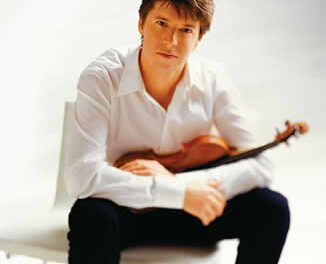The Winston-Salem Symphony. under the baton of Music Director Robert Moody, began the new year Saturday night with music by Haydn, Beethoven, and Strauss, all three of whom are cultural icons of Vienna.
The evening opened with Haydn’s delightful four-movement Symphony No. 69 in C Major. The work, which was composed in 1775-76, has the subtitle “Laudon,” after a famous general in the Austrian army; according to the program notes by David Levy, the publisher tacked on the name as a “marketing ploy” to sell more copies to the public.
The opening Vivace, which Moody sprightly conducted without baton, features exposed string lines that were cleanly and elegantly played. Since Saturday concerts are “Kicked-Back Classics,” the atmosphere is a bit more relaxed than the traditional performances. A drop screen provided a blow-by-blow description of what was happening in the music, including an explanation that, during Haydn’s time, it was common for the audience to applaud after the first movement. The Stevens Center audience dutifully followed cue.
The slow second movement contains a stormy middle section which provided some drama to overall suave character. The Minuet is a hearty dance, with a trio that features only the strings. The finale (Presto) containes some solid solo string work by the principal players and brought the piece to a good-natured conclusion.
Beethoven was about to write his Fifth and Sixth symphonies when he composed his only Violin Concerto; he was the undisputed master of orchestral music. Composed in 1806, the three-movement work stands as a giant in the literature.
The Austro-Hungarian Christoph Koncz, a 20-something violinist who is based in Vienna, with the VPO, proved to be a magnificent advocate for the work. His playing was remarkably clean and clear with impeccable intonation. His long, drawn out trills were a model of clarity. His double-stop playing in the virtuosic passages was magnificent and his lyric playing was absolute heaven.
However, to this listener the opening Allegro ma non troppo (Fast, but not too much) was much too slow. To be sure, a relaxed interpretation allows for exploration of nuance and subtlety, of which Koncz took full advantage. But one loses the drive and power inherent in the score at such a tempo. Furthermore, the slow second movement thus gave up some of its function as a contrast to the nominally faster first movement. For the record, the Finale moved along quite nicely and finished the concerto in fine fashion.
Richard Strauss’ opera Der Rosenkavalier (The Knight of the Rose), which premiered in Dresden in 1911, was an immediate success; music from the opera was subsequently arranged as an orchestral suite. It has been an audience favorite ever since.
And no wonder – Strauss’ ability musically to express the mood and character of the stage production make him one of the great opera composers. During the performance of this work, the projection on the drop down screen was a great help in explaining what was taking place in the opera.
The orchestra played with verve and passion. The climactic moments were thrilling, with the full orchestra playing at the top of its lungs. And the ensemble infused the gentle, tender passages with love and care. Strauss was a master of orchestral color, and the musicians brought the different hues into vivid relief. Throughout it all, Moody (who was conducting without a score) goaded the group to give its all.
The concert ended with a work not on the program, but one that is quintessentially Viennese – a romping performance of the “Radetsky March” by Johann Strauss, Sr.
This program will be repeated on January 11 and January 13. For details, see the sidebar.













